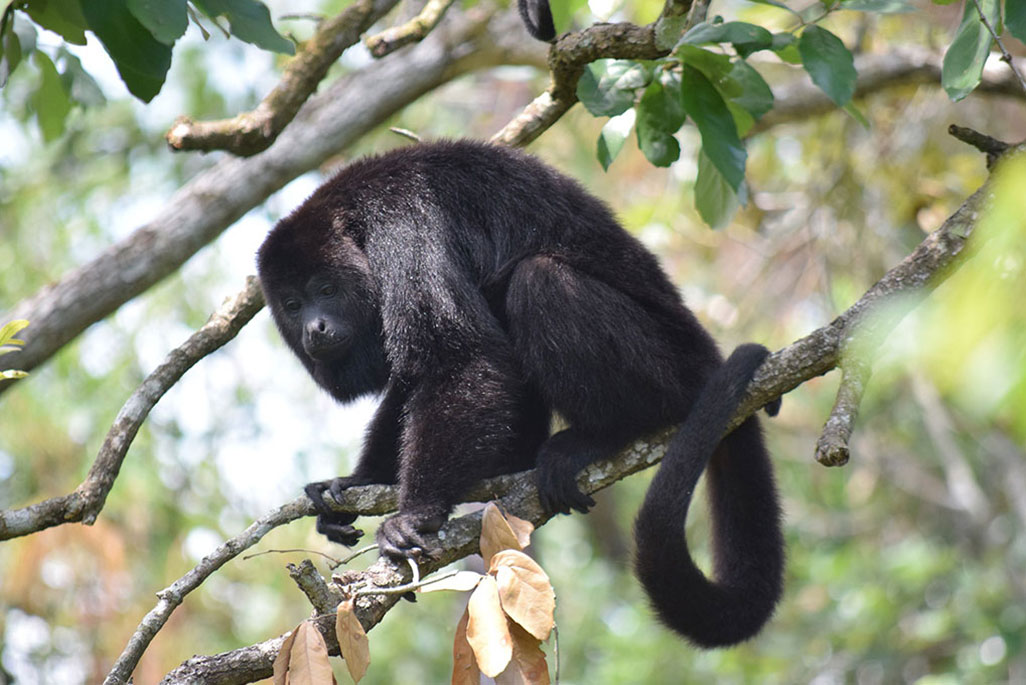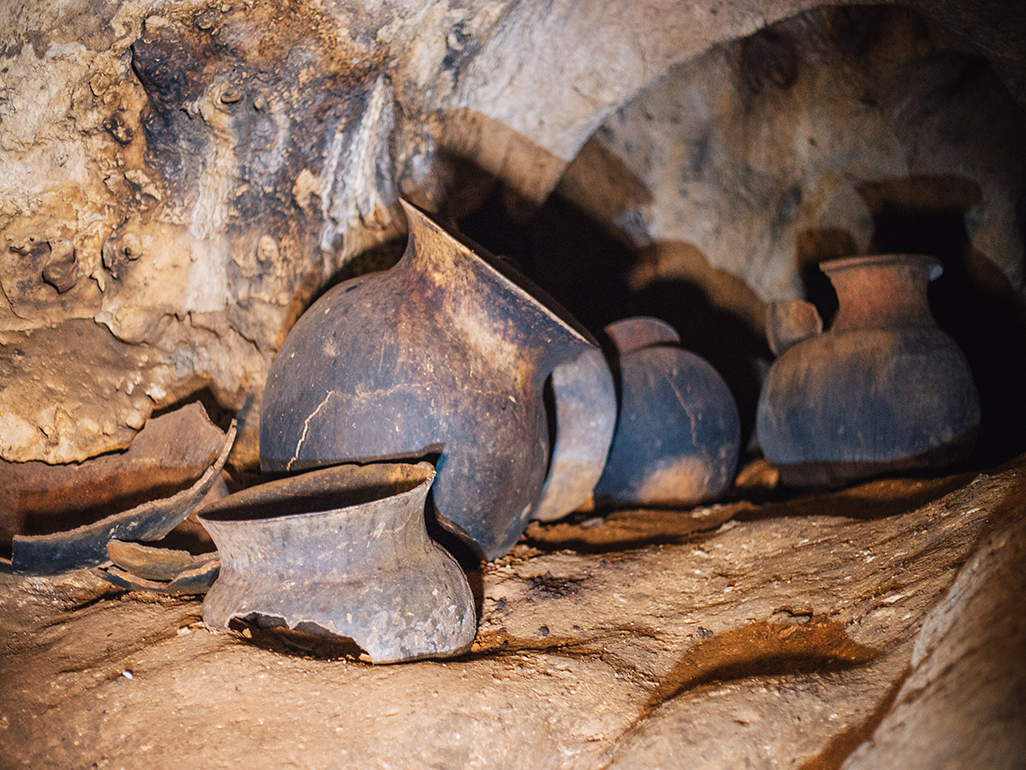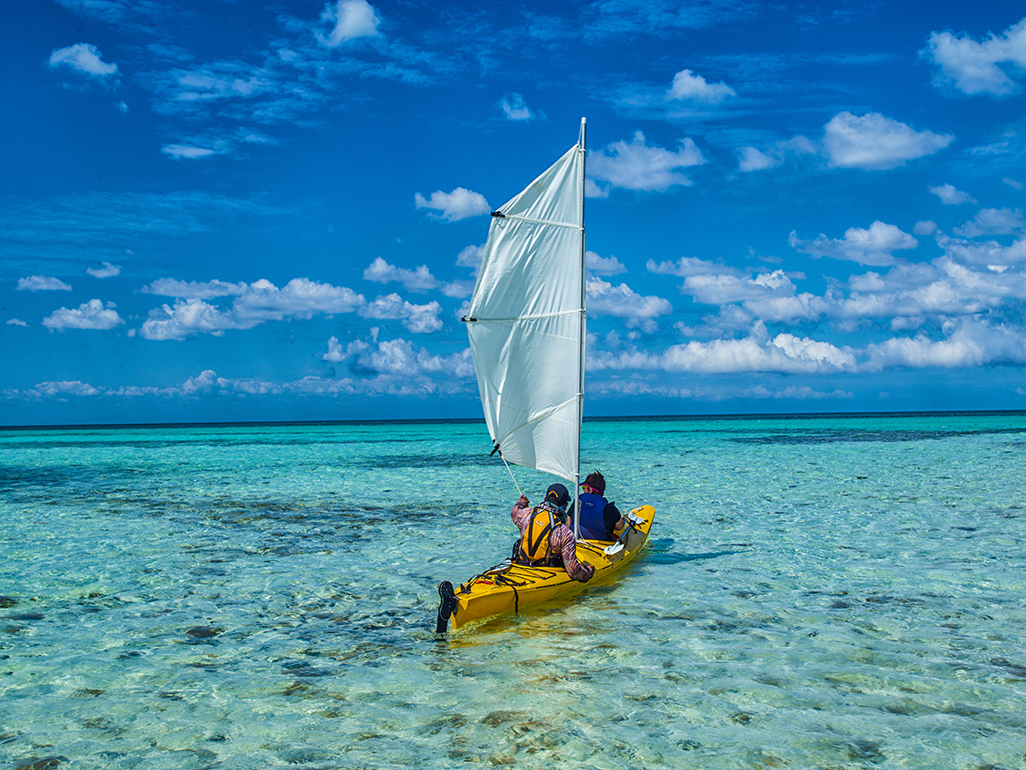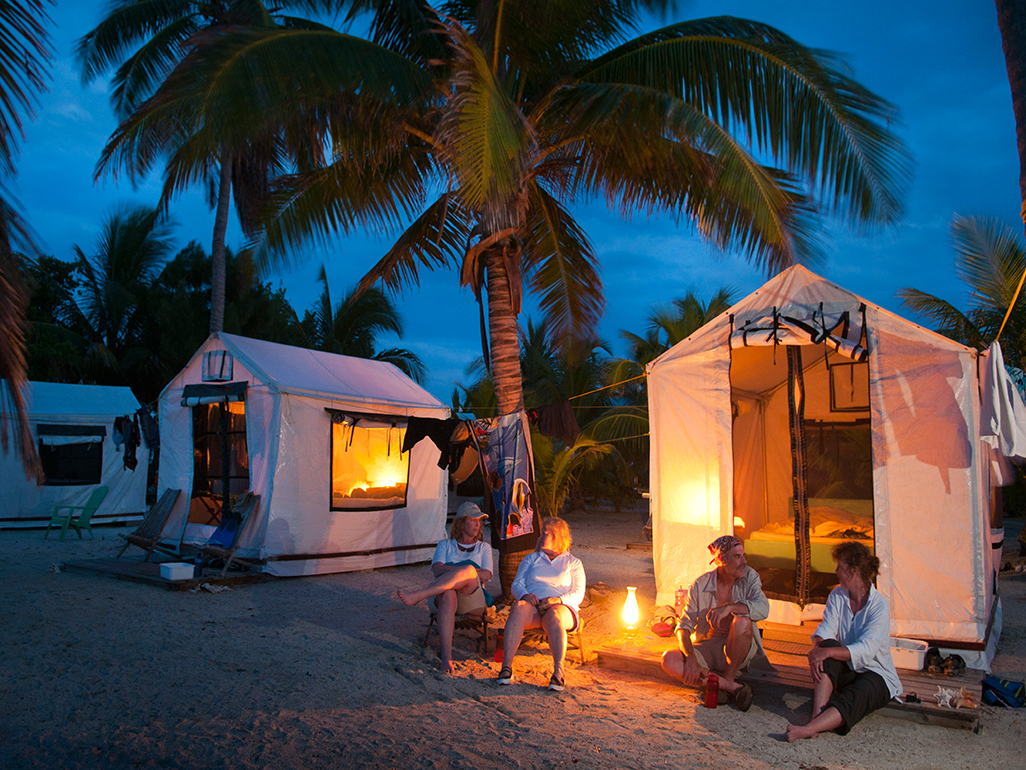Itinerary
Glover’s Reef and Mayan Caves combines an inland exploration of Mayan ruins and rainforest caves with the opportunity to explore and stay on a remote coral atoll.
Glover’s Reef is part of the world famous Belize Barrier Reef, a protected marine park and designated UNESCO World Heritage site thirty-six miles off the shore of mainland Belize. Perfect for active families and couples of mixed abilities, this adventure Basecamp offers flexibility and choices in daily guided activities, so traveling companions can do things together or separately.
Day 1
Arrive at the Belize International Airport, where you will be met by an Island Expeditions’ representative and transferred to Cahal Pech Village Resort – a picturesque lodge carved out of the land with a grand vista overlooking the town of San Ignacio and the rolling hills of the Cayo District in Western Belize. This is an ideal starting point for the adventure that awaits. This is the day to get in tune with the rhythms of Belize and acclimatize to your new tropical environment. Transfers from the airport, lodging, and dinner are included.
Accommodation: Cahal Pech Village Resort
Meals: Dinner
Day 2
A full day of adventure and exploration. The first mission is to venture into the jungle to explore the underground archaeological site of the Chech’Em Ha Cave system. You’ll hike a half an hour through the rainforest, and up into a multi-chambered series of caves rich with geological formations, ancient ceremonial altars, Maya artifacts, and relics. After an hour and a half in the cave, we hike further downhill to lunch served by our hosts in a spectacular setting overlooking the Macal River valley. The next adventure is the ancient Mayan ruins of Xunantunich. It’s a short drive and then you will cross the Mopan River on a hand-cranked ferry. Situated on the banks of the river, you will travel back through centuries to the world of ancient kings, temples, plazas and the renowned ball courts of this ancient city. In the evening you can stroll into San Ignacio, meet the local people, and enjoy dinner on your own in the town.
Accommodation: Cahal Pech Village Resort
Meals: Breakfast, Lunch (Dinner on your own in San Ignacio)
Day 3 – 6
You’ll depart early in the morning and drive the scenic Hummingbird Highway through the Rainforest to the coastal town of Dangriga. Here you board a charter boat to our remote Basecamp on Southwest Caye. Southwest Caye is located in the Glover’s Reef Marine Reserve. Upon arrival, you’ll receive an introduction to your new environment before settling into your ocean view tent cabana. Our guides will then conduct professional instruction to teach you the fundamentals of sea kayaking, snorkeling, and tropical water safety. After training, enjoy a paddle to a nearby patch reef and start exploring some of the 700 snorkel sites Glover’s Reef Atoll has to offer.
Glover’s Reef is one of the most spectacular marine environments in Belize and offers the best kayaking, snorkeling, and diving in the Caribbean. Due to its isolation from the mainland, the waters are exceptionally clear with a rich reef ecosystem.
Our itinerary is flexible in order to accommodate individual and group preferences. Activities include paddling, snorkeling the inner and outer walls of the reef, SUP and learning to sail a kayak. In the mornings and evenings, we host informative sessions on a range of topics. This allows our guides to share their vast knowledge of Belize, its unique marine environments, and the local culture with you. Guests who prefer a more leisurely pace can always take time to kick back in a hammock and relax with a good book!
Accommodation: Glover’s Reef Basecamp
Meals: Breakfast, Lunch, Dinner
Day 7
Many guests choose to wake up early on this final morning and enjoy a coffee on the dock for the last time. Watch the sunrise over the atoll before enjoying a hearty breakfast. Your boat charter usually departs around midmorning to take you back to the mainland, arriving at approximately noon. Your trip finishes in the Garifuna town of Dangriga, and our helpful staff will assist you in connecting to the next leg of your journey.
Accommodation: n/a
Meals: Breakfast, Packed Lunch
Rates in 2019/2020
Rates are per person, based on double occupancy. For single or triple rates, please inquire.
Rate in USD
- includes taxes & fees
Rate in CAD
- includes taxes & fees
A representative will meet you at the airport. As trip participants will be arriving on different flights throughout Day 1, we have arranged transport to the Biltmore Plaza Hotel as a pleasant and comfortable place to wait for those who have arrived on earlier flights than other group participants. Typically, we will have gathered all trip participants by 4-5pm and be heading on our way to the Tropical Education Center.
1:00-1:30 pm – The first vehicle will depart the International Airport between 1 – 1:30 pm to the Belize Biltmore Plaza Hotel where you will be able to relax by the pool, have a drink at the outdoor bar, eat a meal, and wait for the rest of the guests to arrive. If you arrive earlier than this scheduled pick-up and do not want to wait at the airport for the driver, please feel free to take a cab to the Biltmore Hotel.
The trip ends in Dangriga, which is a short flight away from Belize City. The transfer back to Dangriga is scheduled to arrive there approximately at noon. Please schedule your international departure flight (if on the same day) no earlier than 3pm.
- international flights
- airport fees and taxes
- domestic transport from Dangriga back to Belize City
- costs and fees incurred due to delays or missed flights
- additional arrangements
- Snorkel gear
- personal gear & purchases
- tips
- expenses of a personal nature
Weather
Insects
Yes, there are insects, including some that can carry nasty diseases. It is important to protect yourself adequately by wearing light-weight, long-sleeved shirts and pants and by using an effective insect repellent (those containing 15%-20% Deet tend to work quite well). To ward off sand-flies, coconut oil or skin-so-soft has proven most useful.
Electricity, cell phones & devices
The Basecamps (Lighthouse Reef, Glover’s Reef & Billy Hawk Caye) has solar and small fuel generators, which provide 110VAC power in the common areas for several hours each evening. Charging locations are in place for low drain power applications, typically for charging batteries.
However, it is highly recommended to leave unnecessary electronic equipment at home. The humidity and sand do not do the sensitive devices much good and you won’t believe the amazing extra benefit you get just from unplugging for a few days. Besides, electronic devices count as luxuries that few people can afford in these parts of the world. Thus, they represent an unnecessary temptation. Neither the tour operator nor we take any responsibility for lost, stolen or damaged items. Please make sure all such items are adequately protected and safely stored.
Cellular with Data Service is available in many parts of Belize. Service is less reliable as you head offshore and in many of the more remote inland areas you will find cell service becomes less available. Accessing these services while roaming becomes very expensive.
Snorkeling in the Tropics
For many, the highlight of their trip is the time spent exploring the wonders of the underwater world.
This does not require great skill or expensive equipment to accomplish. IE guides enjoy teaching the simple skills necessary to enjoy snorkeling.
In many of the areas we explore, the water is shallow enough to stand. Initially, we enter the water from a beach but as our skill level increases, we will learn to enter and exit from our kayaks. This will enable us to experience longer and deeper dives as well as drift dives – floating along a patch of coral with our boats drifting behind us.
To ensure the reefs are protected for future generations we avoid damaging the coral by not touching, standing on, or dropping anchor on coral. As a living organism, many corals rely on nematocysts to sting their prey. These same nematocysts can sting humans ranging from mild to strong intensity. Care is taken to show all participants the coral species which should be avoided.
If you get cold easily a lightweight wetsuit or ‘shortie’ is recommended to keep from getting cold when spending extended time in the water. Polypropylene or Capilene long underwear work as well. In addition, this clothing also protects against sunburn. We highly recommend wetsuits for children.
Purchasing Snorkel Equipment
Knowing how to snorkel and what to watch for are all well and good, but inadequate equipment can spoil the best of conditions.
Therefore it is highly recommended you purchase equipment that fits comfortably. Borrowing a friend’s gear is okay for fins and snorkel but a mask must conform to the individual’s face to ensure a watertight seal. Nothing is more frustrating for snorkelers than water leaking into their masks. When shopping for a mask check for the following:
- A smooth seal around the mask. Both rubber and silicone work well. Check that the material is not cracked, brittle, or stiff – all signs of an old mask.
- Press mask to face and inhale through your nose. DO NOT PUT THE STRAP AROUND YOUR HEAD but leave it off in front of the mask. If the mask seals it will stay on your face even when you tilt your head down. Check that no hair gets between the mask and your face to break the seal.
- Make sure the front of the mask does not press against the bridge of your nose. This will get worse the deeper you dive. Vaseline around the edge of the mask helps for a better seal for men with beards or mustaches.
- Make sure the snorkel fits comfortably in your mouth. With fins, a snug fit is best. Complete foot fins rather than those with a strap around the heel are preferred. Leave enough room for socks if you wish.
- Above all else, try the mask in water (pool, bathtub, etc.) before you arrive in Belize. A good dive shop will gladly exchange an ill-fitting mask for one with a better fit.
Note: Equipment is available for rent in Belize but must be organized in advance. Please ask.
Using a new mask for the first time: New scuba masks have a residue left over from the manufacturing process that coats the lens. Unless this coating is removed from the inside of the lens, your mask will constantly fog up. One simple solution is to use toothpaste. Thoroughly rub the toothpaste around the lens with your finger or a soft cloth – if possible leave it overnight. Then rinse well, removing all the toothpaste. Rinse again and you should be good to go.
Before each snorkel outing: To help avoid your mask fogging up you can spit into your mask, rub the saliva around to coat the lens, and then rinse quickly. You can also coat the lens with a commercial defogging agent or bring a supply of baby shampoo, which works the same – this should be done before every outing.
Insurance
All trip participants are required to get Travel Medical / Evacuation Insurance. We also strongly suggest that you purchase Trip Cancellation Insurance. Some insurance packages include both bundled together.
Start Date |
End Date |
| 2019-11-25 | 2019-12-01 |
| 2019-12-02 | 2019-12-08 |
| 2019-12-09 | 2019-12-15 |
| 2019-12-16 | 2019-12-22 |
| 2019-12-23 | 2019-12-29 |
| 2019-12-30 | 2020-01-05 |
| 2020-01-06 | 2020-01-12 |
| 2020-01-13 | 2020-01-19 |
| 2020-01-20 | 2020-01-26 |
| 2020-01-27 | 2020-02-02 |
| 2020-02-03 | 2020-02-09 |
| 2020-02-10 | 2020-02-16 |
| 2020-02-17 | 2020-02-23 |
| 2020-02-24 | 2020-03-01 |
| 2020-03-02 | 2020-03-08 |
| 2020-03-09 | 2020-03-15 |
| 2020-03-16 | 2020-03-22 |
| 2020-03-23 | 2020-03-29 |
| 2020-03-30 | 2020-04-05 |
| 2020-04-13 | 2020-04-19 |
| 2020-04-20 | 2020-04-26 |
- Passport
- Photocopy of passport
- Air tickets
- Favorite snacks for between meals
- Personal spending and emergency funds
- 1 extra set of clothes for flight home
- 1 pair light running shoes for around camp
- 1 pair watersport sandals or water shoes (Teva’s or Keens are a good choice)
- 1 or 2 pair lightweight quick-dry long pants
- Underwear
- 2-3 pairs of socks
- 2 pair quick-dry nylon shorts and/or loose skirt or sarong
- 1 bathing suit
- 3 t-shirts
- 2 long sleeved shirts preferably with a collar (for protection from the sun & bugs). Silk shirts work well and dry quickly
- 1 fleece jacket or wool sweater (this will keep you warm even when wet)
- 1 good quality rain jacket
- 1 wide-brimmed sunhat (to keep the sun off your face and neck)
- Sunglasses with band (Chums, Croakies, etc.)
- 1 bandana (handy for sun protection)
- Spare set of eyeglasses (even if you wear contact lenses) and contact lens solution
- 1 headlamp and spare batteries
- Mask, fins, snorkel
- Shortie wetsuit, especially for kids (not essential but water temperatures in Dec. and Jan. can be cooler)
- Capilene or polypropylene, or silk long underwear (great for snorkeling)
- 1 liter water bottle
- 1 TOWEL (either a small camp towel or thin beach towel)
- Personal toiletries
- Personal medication and prescriptions
- Small personal First Aid Kit: i.e. Band-Aids, aspirin/Tylenol, scissors, tweezers, safety pins
- Sunscreen – biodegradable reef-friendly sunblock
- Biodegradable soap
- Vaseline, Aloe Vera lotion, or skin care cream
- Caladryl/After Bite/Benadryl Cream or lotion to ease itching from bug bites
- Insect repellent (20 – 100% Deet)
- 2 to 3 garbage bags – serves as extra waterproofing protection and keeps wet gear separate
- Earplugs if you are a light sleeper or sensitive to wave noise and animal/bird sounds
Optional Packing List
- Camera equipment – waterproof or waterproof throw-away camera
- Binoculars
- Bug jacket
- Skin-So-Soft Avon used as a repellent
- Handy Wipe moist tissues for hands and face and/or waterless bacterial cleanser
- Toilet paper for emergency travels
- Lighter
- A good reading book, log book, and pen
- Wine or favorite liquor
- Small day-pack (can be handy on any of our trips)
- Mesh bag for carrying snorkel gear
- Fishing rod and tackle
- Art supplies, sketching tools, or watercolors
- 1 pair of light cotton gloves/bike gloves (for protection from the sun/blisters when paddling)
- Aquasocks
- Foot powder
- Waterproof watch
Supporting local education
Our Programs are aimed to provide grassroots educational assistance in the areas that we travel in. We support local primary schools in the communities that we work in – the Garifuna town of Dangriga, the agricultural village of Silk Grass, and the remote Mayan village of Santa Teresa. We support the Holy Ghost elementary school in Dangriga, the Silk Grass Primary School in Silk Grass Village, and Santa Teresa Village school in Toledo District.
Packing for a purpose
Our “Make Space in your Case” initiative gives you an opportunity to donate school supplies to students in Belize. Share a pound or two of your suitcase/luggage space for materials (pens, pencils, erasers, etc.) and we’ll take care of the rest to make sure the supplies get to the kids and teachers in Belize who need it the most.
We gather the school supplies, packs them off and distributes to the schools and students. Here are some ideas of materials that you can donate to make a real difference in people’s lives.
- Kids story books in English
- Kids story books in Spanish
- Arts and crafts materials
- Colored construction paper
- Colored pencils
- Maps Notebooks
- Solar calculators
- Used textbooks for teachers at any level
- Watercolor paint brushes
CONSERVATION
We also cooperate and support local conservation initiatives, such as Belize Zoo and guests can adopt an animal there through the ‘Adopt an Animal from the Belize Zoo’ – Initiative.
And we also support the Belize Audubon Society by donating a percentage of our revenues generated through the Lighthouse Reef trips. The Belize Audubon Society is a leader in conservation, not only protecting wildlife and habitat, but also by involving local communities in management to ensure sustainable use of natural resources and advocating for maintaining the integrity of the environment in a growing nation.
Water
Fresh water out on the Cayes is at a premium. Most water available on the islands is from rainwater catchment systems or has been imported from the mainland, so water conservation is of the utmost importance to the inhabitants of the islands.
Each lodge will have a closed water system of their own which is controlled with hydro, solar and generator-powered water pumps. Water is pumped into raised black tanks to provide pressure to the system. The water in these tanks is warmed by the sun. At some lodges, this will be the only source of heat. Some facilities will have a propane or electric hot-water-on-demand system. Often generators will be stopped through the night as a conservation measure. This can affect water pressure and availability of light in the night and early morning.
Garbage
Unfortunately, garbage (especially plastics) is found throughout the world’s coastal regions, Belize is no exception.
Weather, wind, and currents can all cause an excessive build-up of garbage to occur along the beaches and in the mangroves. The sad part is that much of this garbage is from offshore and not from mainland Belize. Besides making sure that we leave no garbage while on tour, we try wherever possible to pick up some of this extra refuse. IE organizes a number of work crews each season to clean up the Cayes where we camp and it is an integral part of our educational trip programs.




